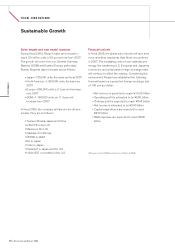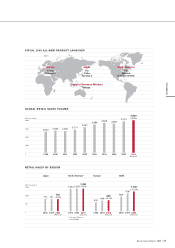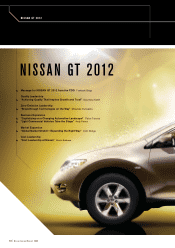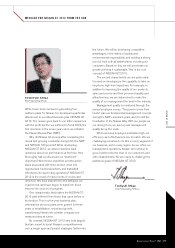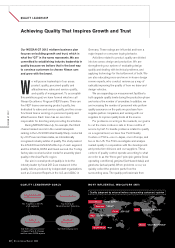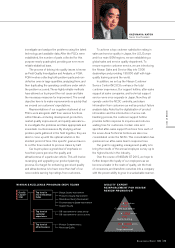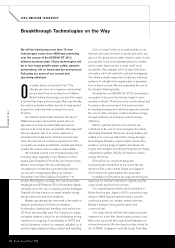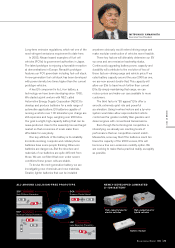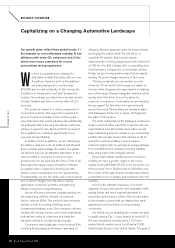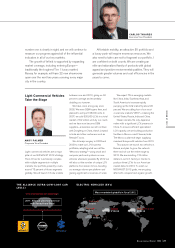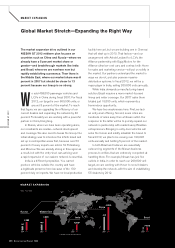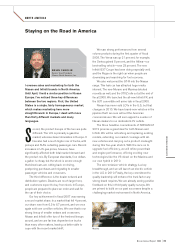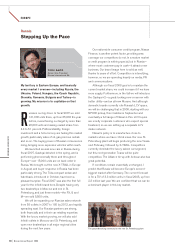Nissan 2008 Annual Report Download - page 28
Download and view the complete annual report
Please find page 28 of the 2008 Nissan annual report below. You can navigate through the pages in the report by either clicking on the pages listed below, or by using the keyword search tool below to find specific information within the annual report.
26 Nissan Annual Report 2008
NISSAN GT 2012
BUSINESS EXPANSION
Capitalizing on a Changing Automotive Landscape
Our growth plans reflect three global trends: 1)
the demand for more affordable mobility; 2) fuel
efficiency with lower CO2emissions; and 3) the
desire from luxury customers for a more
personalized driving experience.
We have a comprehensive strategy for
affordable mobility that starts with our new
A-platform. Vehicles built on this platform
are being designed to cost less than
$10,000 and be sold worldwide. In fact, we say the
A-platform is “designed to cost” and “designed to
localize.” Accordingly, we will produce several models
in India, Thailand and other countries with full LCC
sourcing.
The small car market is a critical component of
our product portfolio. This segment is expected to
grow at 7 percent annually in the next five years—
more than twice the overall industry rate. Additionally,
we anticipate that in the long term these customers
will buy C-segment cars. By fiscal 2012, we expect
the A-platform to contribute significantly to our
revenues and profitability.
In addition to the A-platform, we are developing
the Alliance ultra-low-cost car (AULC) with Renault
and our Indian partner Bajaj. The AULC is a global
car that will serve as an attractive alternative to two-
wheel mobility in emerging economies. Some
question why we are pursuing the AULC. First of all,
this project leverages unique strengths of Nissan:
our global culture, respect for diversity, and the
Alliance, which emphasizes “win-win” partnerships.
Fundamentally, we see the skills, cost-consciousness
and customer insights from the AULC having
applications across the portfolio, strengthening
Nissan’s long-term competitiveness.
As fuel efficiency becomes a greater priority, we
are responding with the ultimate commitment:
electric vehicles (EVs). This switch to zero-emission
mobility is both an exciting challenge and a
fundamental strategic move. Zero-emission vehicles
will alter the industry forever, and ensure that Nissan
both delivers value to customers and leads the
industry’s efforts to combat climate change.
Consumers have legitimate concerns about EVs,
including driving range, performance and ease of
charging. Nissan’s approach goes far beyond simply
developing the vehicle itself. We will deliver a
complete EV solution that includes steady
improvements in driving range beyond the initial level
of 160 km. Our EVs will also offer a compelling level
of performance compared to conventional vehicles.
Finally, we are forming partnerships that are rapidly
building the quick-charge networks of the future.
Thinking creatively, we can envision a world
where we “fill up” an EV with energy in a matter of
minutes while shopping at a supermarket or relaxing
at a coffee shop. Onboard navigation systems would
quickly direct the driver to such locations for
maximum convenience. Fortunately, we are enjoying
strong support for this vision from governments
around the world. Partnerships are already in place
with Kanagawa Prefecture in Japan, Portugal and
the state of Tennessee.
It is worth noting that our EV strategy is not about a
single model, but rather a portfolio of vehicles. We can
expect that as more EV models come online, we will
begin substituting them for models in our conventional
portfolio. We can also foresee that vehicles would be
sold with or without a battery. In some cases a
customer might prefer to purchase an energy package
from a mobility service company, including a battery
lease and access to the charging network.
Beyond affordable mobility and zero-emission
mobility, we have a growth engine in the luxury
market. During NISSAN GT 2012, we will double our
Infiniti volume from 150,000 units to 300,000 units.
Key drivers of this plan include exceptional products,
a relentless focus on quality, and expansion into new
markets.
Infiniti is the ultimate expression of modern
Japanese luxury: both graceful and hospitable, while
setting bolder and more inspired standards for
automotive performance. Infiniti offers an alternative
to stereotypes, a brand with an independent spirit,
appealing to self-confident, uncompromising
consumers.
For Infiniti, we are targeting the number one spot
in quality among Tier 1 luxury brands by fiscal 2012.
We were heartened recently when J. D. Power
ranked Infiniti number two in its influential 2008
Initial Quality Survey in the United States. The goal of


